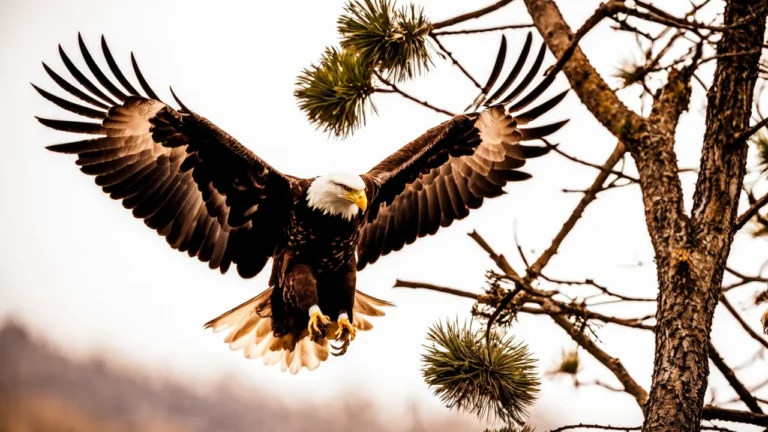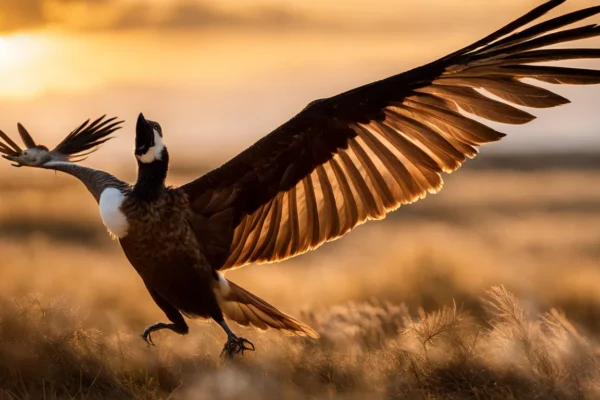The golden eagle is the biggest and most formidable raptor in North America, despite the bald eagle being the official national emblem of the United States. There are notable distinctions between these two eagle species in terms of size, habitat, hunting prowess, state of conservation, and other aspects.
In summary, bald eagles are smaller and more delicate than golden eagles. They live in wide spaces and chase prey with exceptional speed and agility. Bald eagles inhabit places close to huge bodies of water and mostly feed on fish.
This extensive blog post explores the key areas of similarity between the two kinds of eagles. You will gain knowledge about their physical characteristics, dietary habits, favored habitats, population status, relationships, and importance to different North American civilizations.
Dimensions and Anatomical Disparities
The Golden Eagle and Bald Eagle are distinguished from one another by a number of significant physical features.
Comparison of Length and Weight
The magnificent size and power of the Golden Eagle are well-known. Its typical weight is 8 to 14 pounds (3.6 to 6.3 kilograms), and its length from head to tail is 30 to 40 inches (76 to 102 cm).
But the Bald Eagle is a little bigger bird, weighing between 10 and 14 pounds (4.5 and 6.3 kilograms) and growing to a length of 32 to 40 inches (81 to 102 cm).

Variations in Wingspans
The Golden Eagle and Bald Eagle vary significantly in terms of wingspan as well. The wingspan of the Bald Eagle is significantly larger, ranging from 6.5 to 7.5 feet (1.9 to 2.3 meters), compared to the average of 6 to 7.5 feet (1.8 to 2.3 meters) for the Golden Eagle.
The Bald Eagle has an edge when it comes to gliding and soaring through the air because of its wider wingspan.
Size of the Legs and Feet
The Golden Eagle’s legs are longer and stronger than the Bald Eagle’s, and it has larger feet overall. This allows the Golden Eagle to capture and carry larger prey. It is also simple for the Golden Eagle to grab its prey because to its powerful, pointed talons.
However, the Bald Eagle is better suited for scavenging and fish hunting because to its smaller feet and shorter legs.
Variations in Beaks
There are also noticeable variations in the beaks of the Bald and Golden eagles. The Bald Eagle has a big, strong beak with a sharp, curved tip that is great for grabbing and hanging onto fish, while the Golden Eagle has a strong, hooked beak that is perfect for ripping apart its meal.
Coloration of Plumage
The hue of their plumage is one of the most obvious distinctions between the Golden Eagle and Bald Eagle. The body of the Golden Eagle is covered with dark brown feathers, but its head and back have golden feathers.
On the other hand, the Bald Eagle’s body is covered in dark brown feathers and it has a characteristic white head and tail.
You may visit All About Birds and All About Birds for further information about Bald and Golden Eagles.

Preference and Range of Habitats
Habitat of the Golden Eagle
The Golden Eagle is renowned for its broad range and ability to adapt to a variety of environments. It is found in arid environments as well as wide grasslands and hilly places. These magnificent birds choose environments that have wide areas that provide them a good perspective of their surroundings and enable them to see their prey from a distance.
Because they can use these locations to their advantage while hunting, they often construct their nests in towering trees or on cliffs.
Bald Eagle Environment
However, the Bald Eagle favors environments close to bodies of water, like rivers, lakes, and beaches. It is hardly surprising that they choose areas with plenty of fishing chances given that fish are their main food source.
In addition to favoring regions with towering trees, bald eagles often choose nesting sites close to bodies of water to provide convenient access to their food supply.
Distribution and Scope in North America
Although they have different ranges, both the Golden Eagle and the Bald Eagle may be found throughout North America. The range of the Golden Eagle is broader, extending from Alaska and Canada all the way down to Mexico. Additionally, regions of North Africa, Asia, and Europe are home to them.
However, the Bald Eagle’s range encompasses much of North America, from Alaska and Canada to the contiguous United States and even certain areas of Mexico.
Role of Ecosystem and Niche
Both the Bald Eagle and the Golden Eagle are important members of their respective ecosystems as apex predators. The Bald Eagle is an expert fisherman, whereas the Golden Eagle mostly eats small animals like ground squirrels and rabbits.
certain eagles contribute to the preservation of the ecological balance in their habitats by managing the numbers of certain prey species.
It’s crucial to remember that the data presented here only offers a broad picture of the habitat preferences and ranges of the Bald Eagle and Golden Eagle. Make sure to check reliable sources like the U.S. Department of Agriculture or the Audubon Society for more precise and in-depth information.
The Comparison of Prey Diet and Hunting Skills
The diets of Bald Eagles and Golden Eagles vary somewhat. The Golden Eagle is renowned for its varied food, which consists of huge insects, birds, reptiles, and small to medium-sized animals. They’ve been seen pursuing foxes, squirrels, and rabbits.
The Bald Eagle, on the other hand, is an expert fisherman since it eats fish exclusively. They swoop down to hunt fish with their talons, and they are often seen close to rivers, lakes, and coasts.
Hunting Techniques
Each eagle has a distinct hunting technique that works for it and its prey. The ability of the Golden Eagle to fly high in the sky and detect its prey from a distance makes it a formidable and nimble predator. When it sees anything that could be food, it will dive down at breakneck speed to get it.
In contrast, the Bald Eagle uses a sit-and-wait tactic when it is close to bodies of water. It waits calmly on rocks or trees, scanning the water for fish, then swooping down to grab them with its razor-sharp claws.
Velocity and aerial dexterity
The Golden Eagle leads in terms of speed and aerial dexterity. During its hunting dives, it may reach speeds of up to 150 miles per hour (240 kilometers per hour). It can surprise its targets and snag swift prey because to its quickness.
The speed of the Bald Eagle, while still remarkable when in the air, is a little bit slower, with an estimated range of 40–60 miles per hour (64–97 kilometers per hour).
Talon Power
Although both eagles have robust talons, the Golden Eagle is said to have bigger and stronger talons than the Bald Eagle. The Golden Eagle’s strong, keen talons allow it to seize and paralyze bigger prey. The talons of the Bald Eagle are more effective in capturing fish and smaller prey.
Grabbing Actions
Although they are both excellent hunters, the Bald Eagle prefers to scavenge more. Near coasts, bald eagles are often seen foraging for carrion or robbing other birds of their prey.
They have a reputation for seizing openings and robbing other predators of their meal without hesitation. Conversely, golden eagles depend less on scavenging and more on their hunting prowess.
Status of Conservation
Because these amazing raptors have encountered several difficulties in the past, it is crucial to understand the conservation status of the Bald Eagle and Golden Eagle. Here, we’ll examine the variations in their conservation statuses as well as the initiatives taken to keep these magnificent animals safe.
Populations of Golden Eagles
There are populations of Golden Eagles in North America, Europe, Asia, and Northern Africa, and they are extensively dispersed across the Northern Hemisphere. The Golden Eagle is not officially classified as endangered or threatened in North America.
To sustain healthy populations, it is still crucial to keep an eye on their numbers and make sure their habitats are safeguarded.
Bald Eagle Rescue
In contrast, the Bald Eagle has recovered remarkably over the last several decades. The Bald Eagle was once in danger of becoming extinct in the United States, but in 1967 the Endangered Species Act placed it on the endangered list.
The Bald Eagle population has greatly increased as a result of committed conservation initiatives and the outlawing of dangerous pesticides such chemical DDT. It was taken off the list of endangered species in 2007 and is now classified as a species of least concern.
Disparities in Legal Protection
The Bald Eagle and the Golden Eagle have different legal safeguards. The Bald and Golden Eagle Protection Act safeguards Bald Eagles from taking, possessing, selling, buying, bartering, offering to sell, buying, or bartering, transporting, exporting, or importing any Bald or Golden Eagle, alive or dead, including any part, nest, or egg, unless authorized by permit.
Serious penalties and jail time are possible for breaking this statute.
Nonetheless, the Migratory Bird Treaty Act, which safeguards a variety of migratory species, including the Golden Eagle, also protects the eagle. But compared to the Bald Eagle, the Golden Eagle does not have as many legal safeguards.
The variations in their conservation statuses and the particular difficulties they encounter are reflected in the disparities in their legal protection.
Dangers We Face Now
The populations of the golden and bald eagles are now under jeopardy. Their existence is seriously hampered by human activities including pollution, habitat degradation, and the usage of lead bullets.
For both species, accidents with wind turbines and electricity wires are also a hazard.
To lessen these dangers and save these amazing birds, efforts are being done. To guarantee the long-term survival of both the Golden Eagle and the Bald Eagle, groups like the National Audubon Society and the Raptor Resource Project constantly monitor populations, carry out research, and put conservation measures into place.
Visit the websites of the Raptor Resource Project at www.raptorresource.org and the National Audubon Society at www.audubon.org for further information on the protection of these amazing birds.
Cultural Importance
In many facets of culture, the Golden Eagle and the Bald Eagle are very significant cultural symbols. These magnificent birds have captivated people’s imaginations for generations, both via Native American culture and through their usage as national icons in art and media.
American Indian Culture
Both the golden and bald eagles are revered as strong, holy creatures in Native American tradition. They are often seen as symbols of fortitude, bravery, and spirituality. These birds are regarded by many cultures as messengers between the spiritual and material realms.
Their feathers are highly prized and used in regalia, traditional dances, and religious events.
Numerous American Indian tribes have a special regard for the Bald Eagle, according to the National Museum of the American Indian. It represents strength, independence, and knowledge. On the other side, the Golden Eagle is often portrayed as a guardian and is connected to courage.
The American national symbol.
The national bird and emblem of the United States, the bald eagle, is highly revered in American culture. Its magnificent look, power, and long lifetime led to its selection as the national symbol in 1782.
The Bald Eagle, which stands for the principles of liberty, independence, and patriotism, is often seen on governmental seals, coinage, and official documents.
The Bald and Golden Eagle Protection Act, which forbids the ownership, sale, or taking of these birds without the required permissions, protects the Bald Eagle as a national emblem. To guarantee their continuous existence in the American environment, conservation and habitat protection initiatives have been implemented.
Utilize in Media and Art
Both the Golden and Bald Eagles are famous topics in art and culture because of their beauty and symbolic meaning. Their magnificent presence has been captured in paintings, sculptures, and pictures, leaving onlookers in awe.
These eagles, which stand for strength, independence, and resiliency, have also been portrayed in music, poetry, and literary works. They are now recognized as famous characters in wildlife photography, documentaries, and movies because of their elegant flying and captivating gaze.
Numerous groups and educational establishments, like the National Geographic Society and the National Audubon Society, have resources devoted to researching and popularizing these species.
Their websites, www.nationalgeographic.org and www.audubon.org, provide insightful details on the conservation initiatives and cultural value of these magnificent birds.
Final Thoughts
There are significant distinctions between the golden and bald eagles in terms of size, habitat, hunting prowess, status as a protected species, and cultural significance. The golden eagle is a formidable predator deserving of respect, while the bald eagle is an iconic symbol of the United States.
Gaining knowledge about these two magnificent eagle species helps us to better understand the complex raptor ecosystem of North America and the significance of ongoing conservation efforts.






